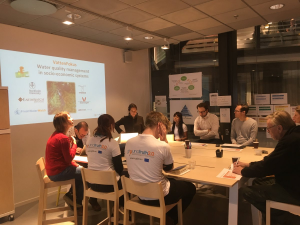Blog: Human-computer interaction competence at the core of the socio-technical approach of Ground Truth 2.0
Situated at the intersection of computer, behavioral and social sciences, Human-computer interaction (HCI) is an area of research and practice that emerged in the 1980s. It brings together researchers, designers, developers and practitioners interested in the design, development and implementation of technologies to support the way people communicate and interact in their everyday and working lives. Central to HCI is the development and evaluation of computer systems that conform to usability standards and user experience principles. The field is also compelled by the development of frameworks, knowledge and methodologies able to account for how users’ practices and activities both configure and are configured by computer systems. The socio-technical approach adopted in the Ground Truth 2.0 project builds on competence in HCI within the consortium, namely IHE Delft and Stockholm University.
 More specifically, HCI competence within the project contributes to the design of citizen observatories that not only provide citizens with a variety of tools for data collection, environmental monitoring and measurements of distinct environmental indicators, but also with functionalities and services that open doors to new and sustainable forms of citizen engagement, participation and empowerment.
More specifically, HCI competence within the project contributes to the design of citizen observatories that not only provide citizens with a variety of tools for data collection, environmental monitoring and measurements of distinct environmental indicators, but also with functionalities and services that open doors to new and sustainable forms of citizen engagement, participation and empowerment.
In particular, the co-design and implementation of citizen observatories for decision making, co-operative planning and environmental stewardship entail the use of a variety of user-centered design methods to establish and maintain relationships between citizens, their environmental data and policy makers through their use of technologies. In this context, HCI competence is reflected in the use of methods and the design of tools that support citizens to engage in open dialogues with their local communities and with policy makers and government representatives. Such HCI methods and tools take account of citizens’ needs, practices and activities in the development of complex infrastructures such as citizen observatories.
 The design and development of citizen observatories differ from design initiatives interested in only providing tools so citizens can become scientists by means of collection of data about the environment. Going beyond that, the design of the citizen observatories in the GT project aims at bringing the citizen closer to the different stakeholders that are concerned and/or are part of specific environmental issues in order to provide them with a series of tools for civic actions. As such HCI competence is needed for understanding that the technology component in the project is not only a matter of designing usable, safe and enjoyable tools for the users, but also of designing tools for bringing publics – that is a group of people confederated by a specific issue – together. In this sense, HCI expertise in the project is grounded in the Scandinavian participatory design philosophy that puts emphasis on democratic values and on ‘infrastructuring’ public action in the design and development of citizen observatories.
The design and development of citizen observatories differ from design initiatives interested in only providing tools so citizens can become scientists by means of collection of data about the environment. Going beyond that, the design of the citizen observatories in the GT project aims at bringing the citizen closer to the different stakeholders that are concerned and/or are part of specific environmental issues in order to provide them with a series of tools for civic actions. As such HCI competence is needed for understanding that the technology component in the project is not only a matter of designing usable, safe and enjoyable tools for the users, but also of designing tools for bringing publics – that is a group of people confederated by a specific issue – together. In this sense, HCI expertise in the project is grounded in the Scandinavian participatory design philosophy that puts emphasis on democratic values and on ‘infrastructuring’ public action in the design and development of citizen observatories.
